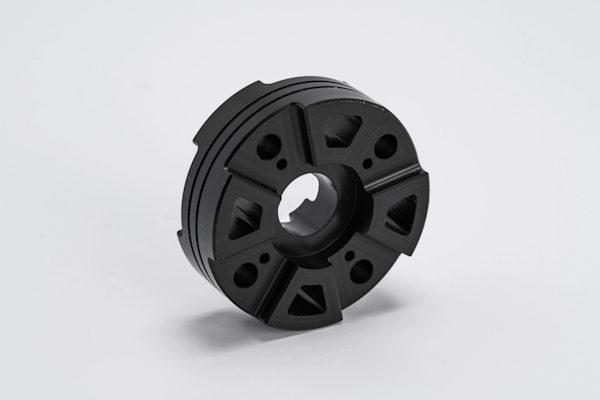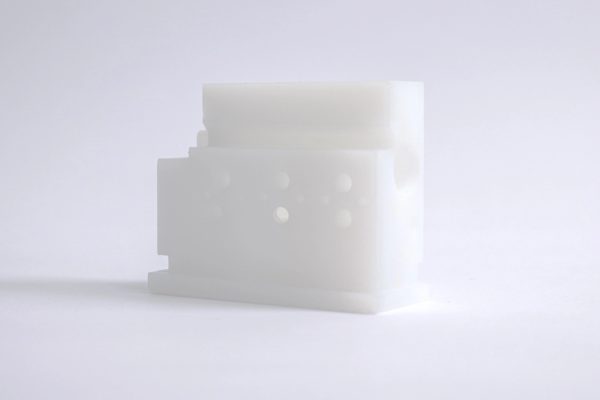Materials for manufacturing
There are many types of materials for manufacturing. Which materials are available for 3D printing, CNC machining, injection molding and sheet metal fabrication? How do you choose the right one for your design? Understanding what materials are made of and their unique cosmetic and mechanical qualities is essential. These articles cover key material characteristics, optimal use cases and more.

Manufacturing with polycarbonate vs acrylic
Polycarbonate and acrylic are two popular materials known for their transparency and versatility. They share many similarities, but their key differences are important to know when choosing a material to create your parts.

What are metalloids and how are they used in manufacturing?
Every time you use your smartphone, drive a fuel-efficient car, or check the time on a smartwatch, you’re benefiting from the peculiar properties of metalloids. These elements, which bridge the gap between metals and nonmetals, play a critical role in creating lightweight, high-performance components across industries. This article will break down what metalloids are, why they matter, and how they’re shaping the future of manufacturing

What is TPU and when should you use it?
Get to know more about thermoplastic polyurethane (TPU) as a manufacturing material. Used for a broad range of applications, TPU’s unique properties make it ideal for both industrial parts and consumer goods.

A guide to heat treatments and tempers
Choosing the right heat treatment or temper is one of the most important factors in creating a part that is optimized for specific applications or engineering challenges.

3D printing with PLA vs. ABS: What's the difference?
PLA and ABS are two essential materials for 3D printing with FDM. They are also two of the most popular materials on our platform. This comparison will help you choose which material to use for your 3D-printed custom parts.

Nylon vs. polyamides: how are they used in manufacturing?
Nylon and polyamides are used in manufacturing when engineers require materials that provide mechanical strength, chemical resistance, and versatility. But are polyamides and nylon the same?

What is Delrin (POM-H) and what are its material properties?
What is Delrin and why is it unique among the many manufacturing materials available? Delrin, or POM-H (homopolymer acetal), is used in CNC machining, 3D printing and injection molding to create durable, precise components. This article explores Delrin’s properties and how to get the most out of the material.

What materials do we offer for CNC machining?
What’s the best material for machining your parts? Check out this side-by-side comparison of the strength, price and application for CNC plastics and metals (in a handy, printable poster).

What’s the right resin for SLA? 3D printing materials compared
What are the different materials available for SLA 3D printing? This article compares the main printing resins, including standard, tough, durable, heat resistant, rubber-like, dental and castable, by material properties. Find the best material option for your application.

What’s the ideal filament for FDM 3D printing? 3D printing materials compared
What’s the ideal material to use when 3D printing parts with FDM? This article compares the most common FDM 3D printing filaments, including PLA, ABS, PET, Nylon, TPU (Flexible) and PC, by their material properties to help you find the best option for your application.

The best heat-resistant plastics
Some plastics operate best under high temperatures. Compare the various properties of thermoplastics, thermosets, and elastomers – as well as their many applications – so you can make an informed choice for your parts.

When to use resin in 3D printing
There are many great benefits of 3D printing with resin. Find out when to choose this manufacturing method and what to consider before you start your project.

How do you select the right materials for CNC machining?
This comprehensive guide compares the 25 most common materials used in CNC machining and helps you choose the right one for your application.

Which plastics can be CNC machined?
Plastics have become a go-to material for many industries because they are versatile, affordable, and lightweight. CNC machining, while traditionally used for metals, is also a great manufacturing option for producing plastic components. But not all plastics are created equal. In this article, we’ll explore which plastics can be CNC machined, their benefits, design considerations, and how to select the right plastic for your next project.

Manufacturing with polyethylene vs. polypropylene
If you’re considering using polypropylene or polyethylene, read up on when to choose each material and the suitability of each for various manufacturing methods.

When to use titanium vs. aluminum in manufacturing
Great parts are built from the ground up—starting with the right material. So are you ready to test your metal? Titanium and aluminum are two of the most commonly used metals in manufacturing, each with distinct properties and advantages. This guide will help you understand the differences between them and when to use each in your manufacturing process.

3D printed injection molds: Materials compared
We compare critically two industrial 3D printing materials used for low-run injection mold manufacturing.

What is PLA (polylactic acid) filament?
Polylactic acid, also known as PLA, is a thermoplastic material commonly used in additive manufacturing. It is one of the most commonly used materials in 3D printing, and can be used to create a wide range of parts, packaging, and prototypes for the medical, food, cosmetics, and textile industries, among others.

What are the best materials for chemical-resistant parts?
Want to learn more about chemically resistant parts? Find out about common chemical-resistant materials, their advantages, disadvantages, and industrial applications.

3D printing with PLA vs. PETG: What's the difference?
Learn the benefits of PLA and PETG, when you should use one instead of the other, post-processing techniques that work for both materials, and more.







